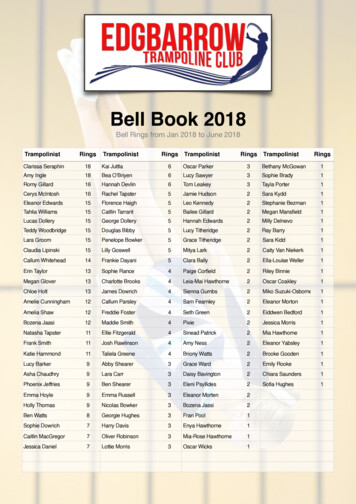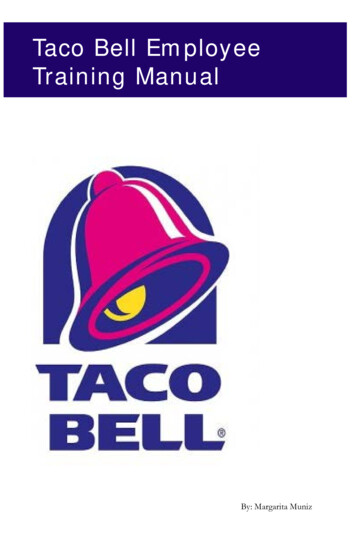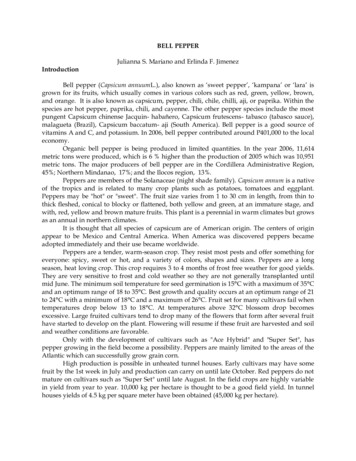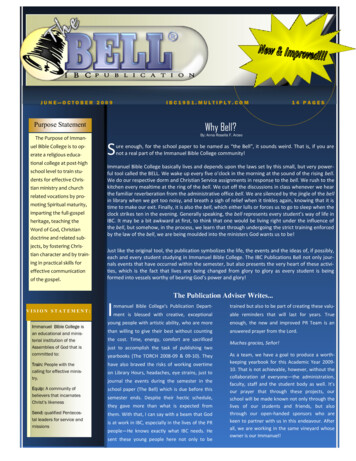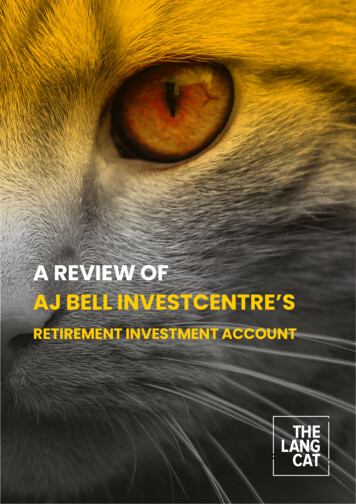
Transcription
A REVIEW OFAJ BELL INVESTCENTRE’SRETIREMENT INVESTMENT ACCOUNT
A REVIEW OF AJ BELL INVESTCENTRE’S RETIREMENT INVESTMENT ACCOUNT . . . . . . . . . . . . . . . . . . . . . . . . . . . . . . . . . . . . . . . March 2021WELCOMEHello and welcome to this short review of AJ Belladvisers tell us they use for more modestly sized pension-Investcentre’s Retirement Investment Account (RIA) ‘product’.only business.Why the inverted commas? Well, this isn’t a new product assuch (although we’ll call it that for convenience in this paper).As we’ll see, it’s more a repriced version of the pensionwrapper regular users of AJ Bell have become used to, withthe investment choice streamlined a little to remove themost complex options.Here we’ll look at the landscape this offering finds itself inand think about the regulatory drivers which might cause anadviser firm to consider it. We’ll look at functionality andprice too – not just in conjunction with the usual platformAs ever, there’s no substitute for your skill and judgement asan adviser in deciding the best solution for your clients –and we all know that the financial plan is a far greaterdeterminant of a good outcome than picking one product overanother. But you have very clear regulatory responsibilities interms of selecting the right kit to use to execute those plans.So we might as well make a decent fist of it.Enjoy the paperMarksuspects, but with an extended cohort of providers whichRULES OF ENGAGEMENTWell, this is the single most awkward kind of paper we could possibly put in front of you. AJ Bell haspaid us to produce this review, and that may (and probably should) make you question its findings.But both the lang cat and AJ Bell were adamant that this should be an independently produced pieceof analysis. It’s worth nothing to AJ Bell if it’s slanted and easily dismissed. And it’s worth less thannothing to us if it compromises our hard-won reputation for straight talking.So we will be sticking to the facts. The lang cat holds what we think is the most comprehensive andaccurate directory of platform functionality and pricing in the UK. As you’ll see, it’s that which drives theanalysis of the RIA and the conclusions we draw.The day we take a pound to say something’s good that we don’t think is, is the day it all comesunstuck for us. Believe that or don’t – but it is the truth.This paperwas originallywritten in January2020 with platformpricing updatedin March 20212
A REVIEW OF AJ BELL INVESTCENTRE’S RETIREMENT INVESTMENT ACCOUNT . . . . . . . . . . . . . . . . . . . . . . . . . . . . . . . . . . . . . . . March 2021EXECUTIVE SUMMARYBoth MiFID II (the second Markets in Financial InstrumentsDirective) and the Product Intervention and ProductGovernance Sourcebook (PROD) make it clearer in aregulatory sense than it’s been for some time, that thesolutions advisers and planners select for clients need to be‘right-sized’. It is difficult to make the case for placing clientswith relatively simple needs in a complex product, especiallyif it is priced at a premium.We see advisers responding through the increased useof simpler packaged products, especially from some lifecompanies, and in an increase in the supply and use ofpackaged investment solutions such as model portfoliosand multi-asset funds.It’s into this landscape that AJ Bell launched a platformpension offering, aimed at those clients who are likely tohave more straightforward needs.THE PRICINGOur analysis shows that adding the RIA positions AJ Bellfirmly at the front of the market in terms of pricing, beforeany bespoke deals other providers may offer. That’s the caselooking at both the pension in isolation (in accumulation anddrawdown) and using a mixed portfolio including ISA and GIA.And yes, we did think about including a straight to themoney heatmap here. But we want you to consider all thefigures in context. So no short cuts today. Sorry (not sorry). Ifyou really do insist though, feel free to head to page 12 buttake a black mark from us.OUR CONCLUSIONSAJ Bell has done something really interesting here – ratherthan repricing its core offering, it’s created a new one withTHE PRODUCTthe same functionality that hits the pricing and investmentoptions sweet spot for advisers considering suitability forThe Retirement Investment Account (RIA) is basically theclients with around 250,000 or less.AJ Bell Investcentre SIPP with a different pricing shape andThis removes that feeling with the existing Investcentre SIPPwithout the access to external discretionary fund managersand ‘off-panel’ investments (including commercial property).All the major areas of functionality in terms of accumulationof AJ Bell’s pension offering being aimed at affluent clientswith more complex needs and should give planners andadvisers a decent additional proposition to consider. Weand drawdown are still there. AJ Bell has a strong drawdownthink particularly for clients in drawdown.offering for the Investcentre SIPP and this reads across toIt’s an aggressive move without being throat-cutting. It alsothe RIA. Fans of three-letter acronyms can also still have anISA and a GIA next to the RIA, but only the pension gets thenew pricing shape.feels timely in a regulatory sense – AJ Bell’s platform nowoffers two pension options, each right-sized for differentgroups of clients.Having said all of that, something cheap and unsuitablewould still be unsuitable. But AJ Bell – our Platform of theYear in 2018 – is already doing a decent job at the platformtable. Its pension proposition is competitive in features termsand we know many advisers value its technical and BDMsupport too. It’s a radical change for what used to beSIPPcentre and SIPPdeal just a few years ago.3
A REVIEW OF AJ BELL INVESTCENTRE’S RETIREMENT INVESTMENT ACCOUNT . . . . . . . . . . . . . . . . . . . . . . . . . . . . . . . . . . . . . . . March 2021THE NEW PRODUCT LANDSCAPE –AND SOME THINGS TO THINK ABOUTEverything is not as it was. Ever since the RDR (Retail Distribution Review),the financial planning profession and the provider industry that suppliesit have been working on creating a viable, sustainable, profitableway of working which preserves suitability at its core. The lastten years or so have been someof the rockiest for the sectorin living memory.A few years ago itlooked like thingswere beginningto settle down alittle, but thatdidn’t last long.The pensionfreedoms and newregulation in theguise of MiFID IIand its UK nephew,(PROD) drove a coachand horses througheverything. Providers andplanners alike have had toscrabble to work out whichway is up in this newenvironment.Of course, that concept ofsuitability remains absolutelyconstant. But as the product landscape has shifted to try andaccommodate the legislators, the regulators and the market itself,we’ve seen some interesting developments which we think are worthbringing to your attention here. How you feel about them mayinfluence whether or not AJ Bell’s RIA is of interest.4
A REVIEW OF AJ BELL INVESTCENTRE’S RETIREMENT INVESTMENT ACCOUNT . . . . . . . . . . . . . . . . . . . . . . . . . . . . . . . . . . . . . . . March 2021THE PLATFORM ARMS RACEPlatforms believe that advisers and planners don’t really want to use multiple providers. Certainly, for many firmsthe platform relationship has become so fundamental that they will use one provider in all but the most clearlyunsuitable situations. That’s fine – but over time platforms have added more and more functionality to try and lockin usage as much as they can. Prices have also remained pretty constant, albeit on a slight downward trend.This has all increased the risk that clients with perhaps very simple needs are being put on platforms with veryhigh levels of sophisticated functionality – and could be paying more than they need to. Is a platform suitable if itoffers far more than a client needs? Opinions vary, but the concept of a ‘right-sized’ type proposition is definitelyone we’ll hear more about over time.THE RETURN OF PACKAGEDWhile many planners and advisers focus on platforms, it’s easy to forget the sheervolume of business flooding into packaged products. Propositions from Royal Londonand Prudential have been massively successful over the last few years, with levels ofnew business that many smaller platforms would give their eye teeth for. These aretypically used for less affluent clients and those with simpler needs, but do requirefirms to be comfortable with the in-house investment options on offer.Firms using these products tell us that they’re low cost, very easy to use (becausethey don’t try to do everything for everyone), and actually good on an ongoingbasis. Most are insured, and so offer a more traditional feel, where administrativeissues can be dealt with behind the veil rather than resulting in very explicit andvisible actions to put the client in the right position.The question is – will platforms be able to hold off the resurgence of packagedproducts, or will there be a continuing drift to these lower cost, very simple options?MODEL PORTFOLIOS IN DECLINEOur research at the lang cat suggests that just under 60% of you run your own model portfolios for atleast some of your clients, with 8% of you having discretionary permissions. Those of you who do sotend to flow about 70% of client monies into them. For those running models on an advisory basis,MiFID II has made the administrative burden considerably greater. Disclosures alone have grown armsand legs, and of course if you’re not running portfolios on a discretionary basis then you need clientpermission before doing anything other than automated rebalancing.As a result, we think we’re seeing more and more firms move away to third-party portfolios or multiasset funds. Platforms are trying to roll out functionality to help with admin, but equally more and moreare offering pre-packed portfolios which aim to take the pain away. The question for firms is: doeshaving your name on the portfolio and the ability to pick funds outweigh the inconvenience – and areyou sure you’re complying with MiFID II rules?5
A REVIEW OF AJ BELL INVESTCENTRE’S RETIREMENT INVESTMENT ACCOUNT . . . . . . . . . . . . . . . . . . . . . . . . . . . . . . . . . . . . . . . March 2021WHAT REGULATION REALLY SAYSABOUT SEGMENTINGIf you’ve been paying any kind of attention over the lasteighteen months or so, you can’t have helped but notice theProduct Intervention and Product Governance Sourcebook– PROD for short – which was introduced at the start of 2018as part of MiFID II.Both PROD and the wider MiFID II have lots to say on awhole range of topics, but that’s beyond our scope here.What’s really important is what PROD has to say on the topicof segmentation.Now, you’ll doubtless have heard various well-meaningMANUFACTURERS3.2.1 A manufacturer must: (1) ensure that the financialinstruments it manufactures are designed to meet the needsof an identified target market of end clients within therelevant category of clients (see COBS 3 for client categories);(2) ensure that the strategy for distribution of the financialinstruments is compatible with the identified target market;and (3) take reasonable steps to ensure that the financialinstrument is distributed to the identified target market.souls exhorting you to segment your clients ‘in line withPROD’. We might even have been some of them, inunguarded moments. But would it blow your mind if we toldyou that PROD doesn’t actually lay down the requirement tosegment clients, let alone in any particular way?Well, if so, prepare to have your synapses frazzled Staywith us as we have a look at the source text1. We need tostop by the rules for manufacturers (providers in thisinstance) and distributors (you; sorry) for this to make sense.3.2.8 Manufacturers must identify the potential targetmarket for each financial instrument at a sufficiently granularlevel and must: (1) specify the type or types of client forwhose needs, characteristics and objectives the financialinstrument is compatible; and (2) identify any group orgroups of client for whose needs, characteristics andobjectives the financial instrument is not compatible.3.2.16 A manufacturer must make available to anydistributor of that financial instrument: (1) all appropriateinformation on the financial instrument; (2) all appropriateinformation on the product approval process; (3) theidentified target market of the financial instrument, includinginformation about the target market assessment undertaken;(4) information about the appropriate channels for distributionof the financial instrument; and must ensure that theinformation is of an adequate standard to enable distributorsto understand and recommend or sell the financialinstrument properly.1. The full PROD rules are available at f6
A REVIEW OF AJ BELL INVESTCENTRE’S RETIREMENT INVESTMENT ACCOUNT . . . . . . . . . . . . . . . . . . . . . . . . . . . . . . . . . . . . . . . March 2021DISTRIBUTORS3.3.1 A distributor must: (1) understand the financialinstruments it distributes to clients; (2) assess the compatibilityof the financial instruments with the needs of the clients towhom it distributes investment services, taking into account themanufacturer’s identified target market of end clients; and (3)ensure that financial instruments are distributed only when thisis in the best interests of the client.3.3.3 Distributors must obtain from MiFID manufacturersclients2” will, in all likelihood, identify different groups ofclients with similar needs.So all isn’t as it seems.For a start, this is the first instance we have found of theregulator suggesting it’s acceptable to considersuitability on a segment basis as well as an individualbasis. That’s good news. If you can identify targetmarkets (or segments) which do have similarcharacteristics (let’s say clients with secured incomeinformation to gain the necessary understanding andthrough a DB scheme who want drawdown from theirknowledge of the financial instruments they intend toSIPP as a non-essential top-up) then you can createdistribute in order to ensure that the financial instrumentsapproaches for that segment.will be distributed in accordance with the needs,characteristics and objectives of the target market.Your individual suitability then is a quick sense-check thatthere is nothing for that individual client which means theydon’t fit the segment, and that there are no mitigating3.3.10 Distributors must identify the target market andfactors (perhaps extreme ill-health, for example).manufacturers; and (2) information they have on their own clients.What this all says is that the company making the stuff needs toREGULATION THATWORKS FOR YOUtell advisers which clients it’s suitable for and which it isn’t.The upshot of this is that – despite what the regulationAdvisers need to know their clients well enough to make surehaters will tell you – this is regulation which supports youthey don’t get ‘suitable’ and ‘not suitable’ mixed up.as planners and advisers. As an advice firm you knowtheir distribution strategy using: (1) the information obtained fromWhat it doesn’t say is that you need to segment by portfoliosize, or lifestage, or hair colour or really anything. However, formost adviser firms a segmented client bank and service offeringwill naturally be the outcome of following the rules. In particular,the requirement for distributors to “identify the target marketand their distribution strategy using: (1) the information obtainedbest what your clients need when they seek yourservices, and this is the first step to successful PRODcompliance. Document these needs and, if you havedifferent groups of clients with different needs,congratulations – you’ve just created a segment. Wecan call it a ‘target market’, but it’s the same thing.from manufacturers; and (2) information they have on their own2. PROD 3.3.10.7
A REVIEW OF AJ BELL INVESTCENTRE’S RETIREMENT INVESTMENT ACCOUNT . . . . . . . . . . . . . . . . . . . . . . . . . . . . . . . . . . . . . . . March 2021WHERE AJ BELL’S RIA SHINES INPrice – as we’ll see shortly – is one of two definingpotential to support those investment requirements wheredifferences between the RIA and AJ Bell’s Investcentre SIPPthere is highly unlikely to be any clear client need.(a tighter set of investment options being the other). It’s clearthrough the pricing shape of the RIA that AJ Bell is aiming tobroaden its target market for pensions to include those whohave more modest portfolios than its typical market to date.So, all other things being equal, the RIA should extend AJBell’s potential suitability reach to those who have in theregion of 250,000 or less in their pension. The same goesfor segments in drawdown (whether taking regular incomeor not) at roughly the same portfolio size.There are risks in directly correlating smaller portfolio sizesto simpler investment requirements and larger portfolio sizesto more complex ones. But that can often be the case inpractice and – while, as we’ll see shortly, the RIA still offersa very broad range of investment options, includinginvestment trusts and ETFs for example – what you don’twant to do is have your clients pay a premium for the8By adding the RIA to its platform we think AJ Bell has givenadvisers and planners more scope to navigate throughthese issues, both when segmenting client banks at thebroad level and making those all-important individual clientsuitability judgements.We’ve seen this type of thing with a few other providers whooffer multiple flavours of the same underlying proposition;it seems a reasonable way of going about things given theexpert nature of the advisers and planners who are selectingthese propositions.Segmentation and target market definition will undoubtedlycontinue to be important – although it’s always worthchecking what the regulations actually say versus whatpeople think they say. In this environment, then, havingpropositions for different groups feels to us to be a sensibleway forward.
A REVIEW OF AJ BELL INVESTCENTRE’S RETIREMENT INVESTMENT ACCOUNT . . . . . . . . . . . . . . . . . . . . . . . . . . . . . . . . . . . . . . . March 2021THE RETIREMENT INVESTMENTACCOUNTLet’s get detailed now about the RIA itself. From a functionality point of view the RIA is essentially the existing AJ Bellplatform SIPP with a new pricing shape and some investment options removed (access to external discretionary fundmanagers and what AJ Bell describes as ‘off-panel’ investments, including commercial property). That means there’s littlepoint in showing a table of differences between the two in terms of functionality here, because there aren’t any of note.What we can do is give you a quick breakdown of what the RIA includes, and then we’ll look at pricing in the next section.ACCUMULATIONStructureSIPP scheme.Transfers in/outYes, via Origo Options.Investment rangeOEICs/UTs (open market range), ETFs, ITs, LSE/AIM listed shares, gilts,corporate bonds, VCTs, some offshore funds.Cash accountYes, one at wrapper level and one for investing through AJ Bell’s Funds &Shares Service. Interest rate 0% on both. Platform charge applies to cash inFunds & Shares Service account.Share class conversionYes, at point of transfer in AJ Bell will convert to cheapest available share class.Periodic checks also carried out.Minimum contributionsNone.Model portfoliosYes.Back office linksIRESS AO and XPLAN, Intelliflo, True Potential, Plum, Moneyinfo (Sammedia)(all push via lightning strike).PrefundingOnly on switching.Rebalance/bulk rebalanceYes/yes (auto available monthly, quarterly, half yearly, yearly).DRAWDOWNUFPLSYesFlexi-accessYesCo
the RIA. Fans of three-letter acronyms can also still have an ISA and a GIA next to the RIA, but only the pension gets the new pricing shape. THE PRICING Our analysis shows that adding the RIA positions AJ Bell firmly at the front of the market in terms of pricing, before any

